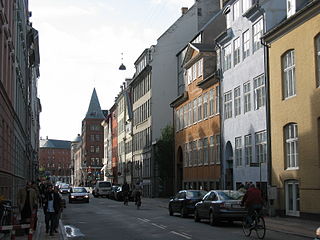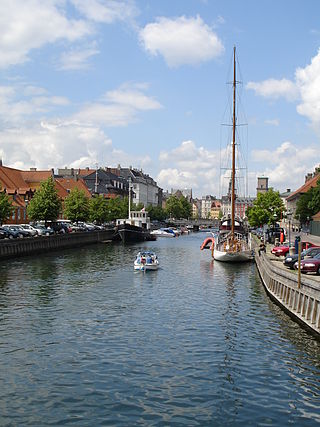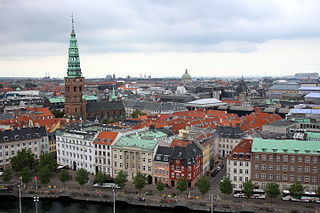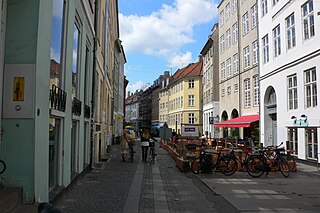
Admiral Hotel is a hotel in central Copenhagen, Denmark, located on the waterfront of the Inner Harbour between the mouth of the Nyhavn canal and the royal residence Amalienborg Palace. The building is a former warehouse.

Sankt Annæ Plads is a public square which marks the border between the Nyhavn area and Frederiksstaden neighborhoods of central Copenhagen, Denmark. It is a long narrow rectangle which extends inland from the waterfront, at a point just north of the Royal Danish Playhouse at the base of the Kvæsthus Pier, now known as Ofelia Plads, until it meets Bredgade. A major renovation of the square was completed in 2016.The Garrison Church is located on the south side of the square. Amaliegade, one of the two axes on which Frederiksstaden is centered, extends from the square.

Borgergade is a street in central Copenhagen, Denmark. It runs from Gothersgade to Store Kongensgade. As one of relatively few streets in central Copenhagen, the street, in its western part, is dominated by modern buildings. The eastern part passes through the Nyboder district.

Toldbodgade is a street in central Copenhagen, Denmark. It extends north from Nyhavn at the Nyhavn Bridge, continuing Holberggade, passes Sankt Annæ Plads after just one block, and continues straight until it reaches West India Warehouse where it makes a sharp left turn which connects it to Amaliegade, its parallel street, at the rear of the Design Museum.

Frederiksholms Kanal is a canal in central Copenhagen, Denmark, which runs along the south-west side of Slotsholmen, together with Slotsholmskanalen separating the island from Zealand. The name also applies to the continuation of Rådhusstræde which follows the canal for most of its course, first on its south side and for the last stretch, from Prinsens Bro and to the waterfront, on both sides of the canal. Several historic buildings face the canal, ranging in size from Prince's Mansion, now housing National Museum, and Christiansborg's riding grounds to the diminutive Stable Boy's House, part of Civiletatens Materialgård, a former storage facility now used by the Royal Danish Academy of Fine Arts's School of Sculpture.

Ved Stranden is a canal side public space and street which runs along a short section of the Zealand side of Slotsholmen Canal in central Copenhagen, Denmark. It begins at Holmens Kanal, opposite the Church of Holmen, and runs west along the canal for one and a half blocks before widening into a small, triangular space adjacent to Højbro Bridge and Højbro Plads. The name of the street refers to Gammel Strand, 'Old Beach', which it formed part of until 1961.

Krystalgade is a street in central Copenhagen, Denmark, connecting Nørregade to Købmagergade. Copenhagen Central Library and the Great Synagogue of Copenhagen are located in the street.

Store Kannikestræde is a street in the Old Town of Copenhagen, Denmark, connecting Frue Plads to Købmagergade. Its history is closely associated with the University of Copenhagen and some of Copenhagen's oldest halls of residence are located in the street. It has been pedestrianized since 1973.

Kultorvet is a public square in the Old Town of Copenhagen, Denmark. Together with Købmagergade and the southern part of Frederiksborggade, it forms a pedestrian zone between Nørreport station and Amagertorv on Strøget. The square is lined with cafés and shops and is a popular venue for outdoor concerts in the summer time. Copenhagen Central Library was from the 1950s based on the square but has now relocated to a building in Krystalgade. Its old building has now been taken over by Niels Brock Copenhagen Business College.

Strædet is the colloquial name of a popular shopping and café street in the Old Town of Copenhagen, Denmark, linking Højbro Plads on Strøget at its eastern end with Regnbuepladsen next to City Hall to the west. The official street names are Læderstræde, Kompagnistræde and Farvergade. The shops along the street are generally smaller and more eclectic than the flagship stores on neighbouring Strøget. It is dominated by art galleries and antique shops. It is known for its rich gay culture with LGBT citizens, shops, bars, restaurants and coffeehouses.

Vandkunsten is a small square in the Old Town of Copenhagen, Denmark. It is located on the corner of Rådhusstræde with Løngangstræde. The name also refers to a fountain from 1910 that stands in the middle of the square.

The Jan von Osten House is a listed Baroque style property at the corner of Amaliegade and Toldbodgade in the Frederiksstaden neighbourhood of central Copenhagen, Denmark. The building was the city home of Johan Frederik Classen from 1770. On his death. it was endowed to the Det Classenske Fideicommis which was headquartered in the building until 1970. The building was listed on the Danish registry of protected buildings and places in 1918.

The Yellow Warehouse, is an 18th-century warehouse located at Toldbodgade 38 on the Larsens Plads waterfront in Copenhagen, Denmark.

Christians Brygge is a waterfront and street in central Copenhagen, Denmark. It runs from the mouth of Slotsholmen Canal in the north to Langebro Bridge in the south where it turns into Kalvebod Brygge. Its northern end, which is located on the small isle of Slotsholmen, is connected to Niels Juels Gade and then Holmens Kanal by Christian IV's Bridge. Christians Brygge The road section is part of Ring 2. The name refers to Christian IV, king of Denmark during the first half of the 17th century, who constructed several buildings at the site, including the Arsenal and Christian IV's Brewhouse as well as nearby Børsen. Other landmarks along the quay include the Royal Danish Library and the mixed-use building BLOX, home to the Danish Architecture Centre.

Frederiksholms Kanal 16–18 are two almost identical listed properties overlooking Frederiksholm Canal in central Copenhagen, Denmark. The Victorian Home, a 15-room, late 19th-century bourgeois home now operated as a historic house museum by the National Museum of Denmark, is located on the second floor of No. 18. The Attorney general (Rigsadvokaten) is based at No. 16. Both buildings were listed on the Danish registry of protected buildings and places by the Danish Heritage Agency on 6 April 1969.

Nyhavn 49 is a listed apartment building situated at the corner overlooking the Nyhavn Canal in central Copenhagen, Denmark. It originates in a two-storey townhouse from 1746 which belonged to the businessman and bank manager Rasmus Kirketerp from at least the 1790s and remained in the hands of the family until at least the early 1850s. This building was later heightened twice, first in the 1850s and then in 1887. The present building contains a ice cream parlour with homemade waffles in the basement and two residential apartments on each of the upper floors. It was listed in the Danish registry of protected buildings and places in 1945. Other notable former residents include the painter Otto Bache.

Amaliegade 8 is a Neoclassical property located in the Frederiksstaden neighbourhood of central Copenhagen, Denmark. The building is from 1785 and was listed on the Danish registry of protected buildings and places in 1918. It is owned by Hempel Group and residents include the Hempel Foundation, the Mary Foundation and the Danish Financial Complaint Boards.
Frantz Philip Nicolai Lange was a Danish architect and master mason. He made a significant contribution to the rebuilding of Copenhagen in the years after the Copenhagen Fire of 1795. Most of his buildings have been listed on the Danish registry of protected buildings and places.

Admiralgade 28 is a Neoclassical building situated at the corner of Admiralgade and Boldhusgade in the Old Town of Copenhagen, Denmark. Constructed in 1798–99 by the prolific master builders Philip Lange and Lauritz Laurberg Thrane as part of the rebuilding of the city following the Copenhagen Fire of 1795., it is now part of a large complex of ministerial buildings which comprises the entire block. The building was listed in the Danish registry of protected buildings and places in 1950. Copenhagen's Student Association (Studenterforeningen) was based in the building from 1824 to 1831 and again from 1742 to 1863. Other notable former residents include the music retailers and publishers CCarl Christian Lose den ældre, merchant and Cherry Heering-manufacturer Peter Heering and the graphical studio Pacht & Crone.

Toldbodgade 9 is a half-timbered building situated in the Nyhavn Quarter of central Copenhagen, Denmark. For about 50 years, from the 1800s until his death in 1852, the property belonged to Henning Hansen Rønne, a skipper from Bornholm, who for a period was alderman of the Skipper's Guild in Copenhagen. The building was later for a while operated as a hotel under the name Hotel Helsingborg. The building was listed in the Danish registry of protected buildings and places in 1918. In 1953, the building was bought by art dealer Viggo Clausen, who subsequently converted it into an art gallery under the name Claussens Kunsthandel. In 2018, Claussens Kunsthandel relocated to new premises at Studiestræde 14. A restaurant administration is now located in the building.



















